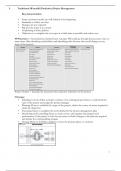Summary
Summary of the Traditional (Waterfall/Predictive) Project Management
This comprehensive document offers an in-depth summary of everything you need to know about Traditional (Waterfall/Predictive) Project Management. It covers the key characteristics of the methodology and provides a thorough introduction to the most common ITTOs (Inputs, Tools/Techniques, and Output...
[Show more]



